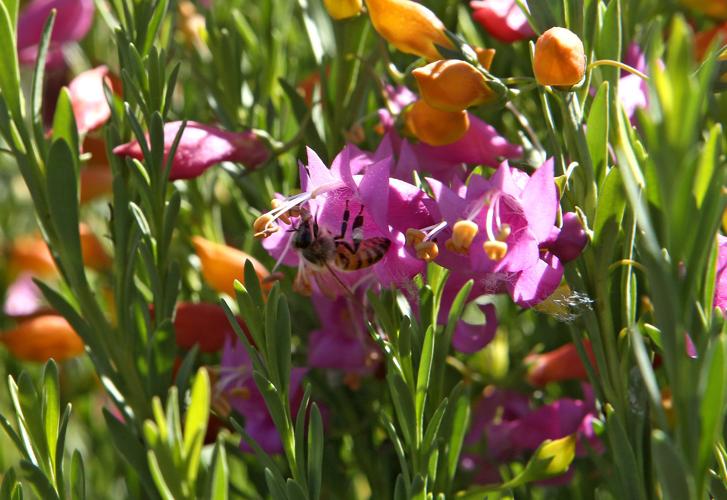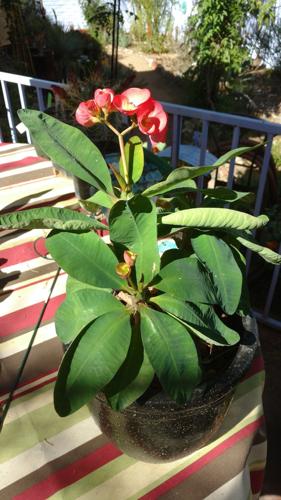Today’s Palm Sunday festivities mark the beginning of Holy Week on the Christian calendar.
It also focuses on one of several plants that are associated with the spring holiday. Here’s a rundown of religious and secular floral symbols that mark the season. All but one can easily grow in Tucson.
BIBLICAL PLANTS
Palms
It’s likely the fronds used to greet Jesus Christ’s return to Jerusalem, according to the biblical story of Palm Sunday, came from the date palm (Phoenix dactylifera), says David Oberpriller, a student of the Bible who guides walking tours at Boyce Thompson Arboretum in Superior.
“That is the most common palm tree and probably the best source of edible dates,” Oberpriller says.
While this species isn’t native to the Sonoran Desert, many other palms grow wild in the subtropical areas of the Sonoran Desert.
For home use, one landscape designer likes the pindo palm (Butia capitata) and the Mexican blue hesper palm (Brahea armata).
Sonya Becker is the design supervisor for Northwest Landscaping LLC. The company regularly uses both species in its designs. Both are hardier in our climate than the popular queen palm, she says.
“One of my favorites is the pindo palm,” Becker says. “It has feather-shaped leaves of light green to bluish gray (that) are more curvy.”
The slow-to-moderate grower from South America reaches up to 20 feet with fronds as long as 10 feet. Its fruit is used to make jelly.
The slow-growing Mexican blue hesper palm—native to Baja California—can reach 40 feet tall after decades of growth. It features fan-shaped fronds and arching spikes of flowers in the spring and summer.
Crown of thorns
The story of Christ’s crucifixion includes mention of a crown of thorns fashioned by Roman soldiers and placed on Christ’s head to mock him as king of the Jews.
Oberpriller says it’s nearly impossible to figure out which species might have been used as the crown. At least 17 have been suggested. And many plants, including four at the arboretum, use “crown of thorns” as a common name.
“Some (species) are very cold-sensitive,” says Paul Ellis, master gardener emeritus with Pima County. “Others don’t have any problems with the cold. Most of them will want filtered sunlight or shade.”
The species Ephorbia milii is easily grown here, says Ellis, who grows several varieties at his home. They provide color from spring through fall.
The variety most available at retail stores are ones with red bracts, leaves that change color. But Ellis grows crown of thorns that have white, yellow or pink bracts, too.
The sap from the plant’s thorny stems and succulent leaves can be an irritant, he says.
He suggests growing crown of thorns in pots so that they can easily be moved to avoid frost damage. He likes to add one-third pumice to two-thirds cactus and succulent soil mix.
Garden author Jacqueline Soule says a Sonoran Desert native plant that’s also called crown of thorns is Koeberlinia spinosa or spiny allthorn. It’s a bushy tangle of spine-tipped branches with pale yellow flowers.
SECULAR PLANTS
Easter lily
The creamy-white trumpet flower originated in Japan and has been cultivated in the United States for nearly 100 years. They are hard to grow in Tucson.
“They don’t like full sun here,” says landscape designer Jason Isenberg,, owner of REALM. “If it happens to be a cold winter, they need some sort of protection.”
Tony Sarah of Magic Gardens nursery says that you can try making the bulb rebloom by saving it after the flowers die.
When the flowers starts to wither, give the soil a shot of phosphorous fertilizer such as fish bone meal. “You want the bulb to take that up and store it for next year’s blooms,” Sarah says.
Once the flower falls off, take the bulb out of the soil, put it in a paper bag and store it in a cool, dark place.
Five to eight weeks before Easter, replant the bulb in a pot rich with compost and other organic soil. Keep the soil moist once the bulb starts growing.
Flowers only last a few days to a week, depending on how hot it is, Sarah warns.
Veterinarian and master gardener Tony Knight cautions that the plant is poisonous to cats.
Easter lily cactus
The easy-growing Easter lily cactus is shaped like a globe from which multiple trumpets of flowers from white to light pink bloom in spring and fall, says Becker.
She suggests keeping them in pots off the ground to ward off hungry critters. The plants like part shade, but do fine in full sun.
“They grow like crazy” and produce several pups for replanting, she says.
Easter egg emu
Another easy seasonal plant is the Easter egg emu bush, an Australian native that isn’t invasive in the Sonoran Desert, says Isenberg.
“It loves the heat, it loves full sun and it’s arid-adapted,” he says of the plant that he likes to use in his designs.
After yellow buds emerge in February and March, the flowers change colors as they mature to orange to pink to pink-purple. A bush with buds in several stages of development can look like an Easter basket full of colored eggs.








